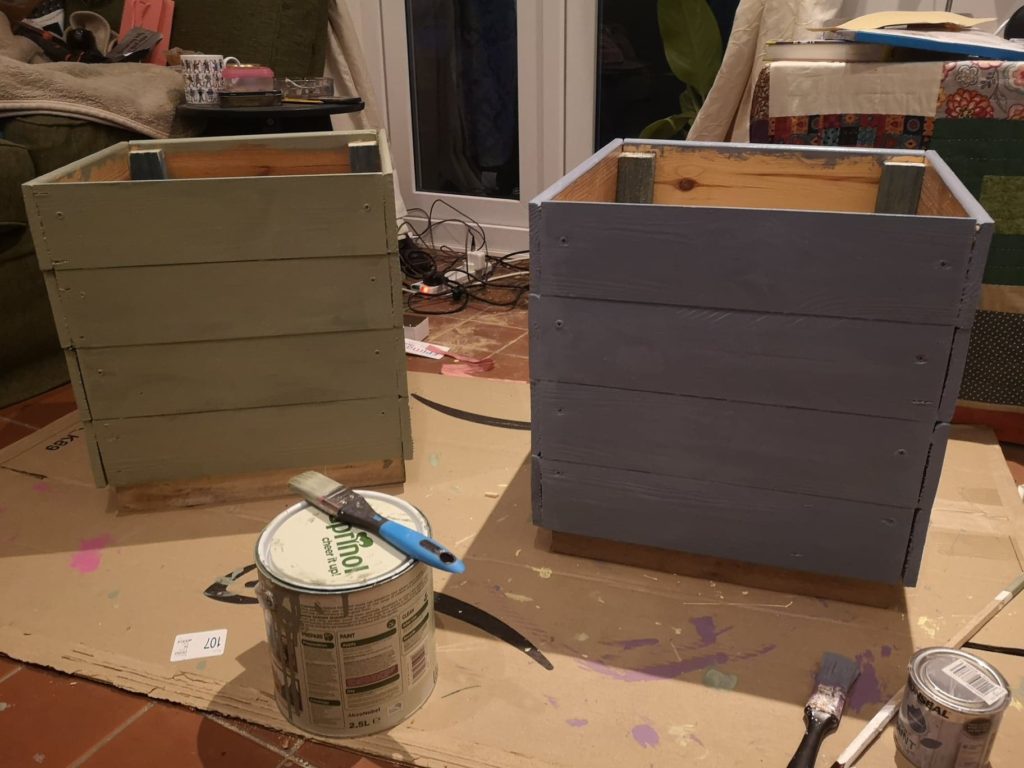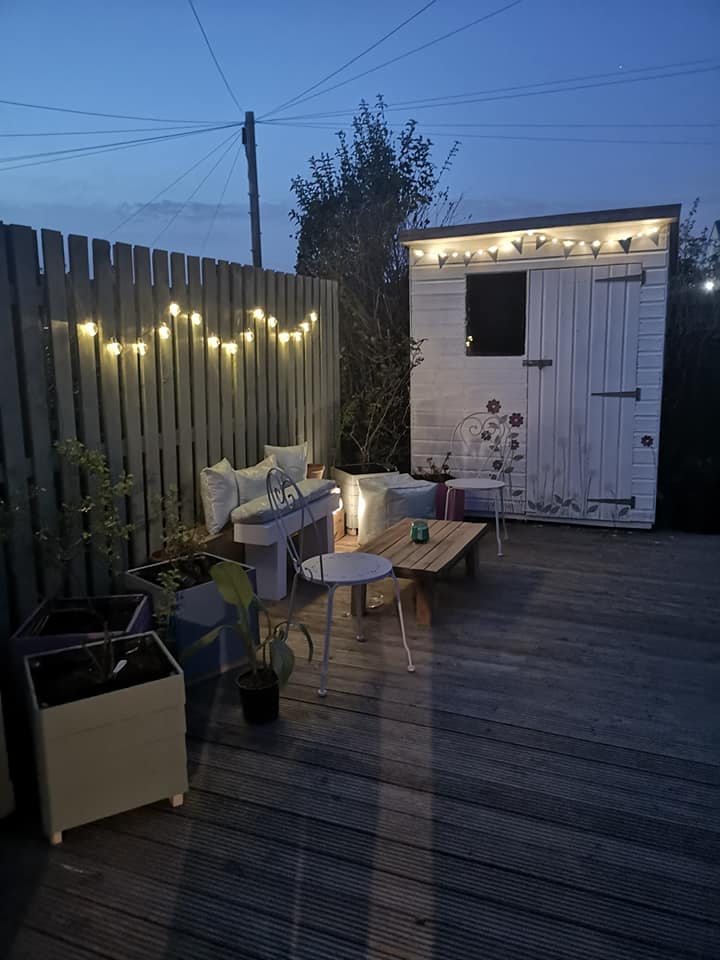Other than re-organising the house (moving furniture and the like), I didn’t do much to the house for the first few months of living here. I did start stripping the stairs, (there’s a blog about them coming soon), but on a whole I didn’t have the motivation to do much. To be fair, I didn’t have much motivation for the stairs either. It took me months to take off the first layer.
One of my main worries with the house was the roof. It looked new. Certainly it looked very different from the other roofs in the block, but probably as a result of other friends having issues with roofs, I was worried about mine. I had water staining in the extension and my loft smelt damp. The matter was taken out of my hands during a particularly wet spell when my guttering broke and began to pour water onto my living room window which was also leaking due to the sealant having worn away. I got Gillespie Roofing and Roughcasting to come and have a look, and they revealed that my roof was indeed a mess. Whoever had installed it had failed to use the right materials and out of the whole main roof and the extension roof, only two tiles were actually nailed down. Ooooft. A new roof it was.
This meant that I had to have a lot of scaffolding put up. The back garden was filled with tiles and all the materials required for a new roof. For two weeks, we had to squeeze past everything, just to take the bins out. From the back room, where I spend most of time, it was not a pretty view. But, something good still came out of that messy back garden. Obviously, there was the lovely shiny new roof (which looks very smart), but preparing for all of that work required me to move all of my plants, which were still in pots after the move (Yes, I did move my entire front garden from one property to another). I moved them all from side of the garden to the other and realised how nice a view it was, with all the plants crowded together, and all the greenery lifting that corner of the garden. Once the roof was finished, I knew I had to change my garden plans.
When we moved in, both the front and back garden were a riot.
There was ivy and ferns growing through the decking boards, and the hedges were overwhelming. The great big one to the right of the shed, I cut back almost immediately and we gained about a meter square of garden. I then cut the rest of that hedge back, so we could at least access the back gate (yes, there is indeed a gate back there. I also cut back vegetation growing through the decking and fences, and gave the decking a really good clean. It was certainly an improvement.
I didn’t go near the garden for months after that. My brother and his wife had come round and cut all the front hedges down for me (unfortunately I don’t have a photo of them), and I bought a little table and chairs. It’s a little sun trap out front, so it seemed like a nice place to sit. I put some slabs down and bought a firepit/pond. I ignored the back garden. I then decided that I would need to cut the hedges down in the back, if I didn’t want the birds nesting in them (there’s a lot birds round here). My lovely friend KT came round and did all the hard work, and the garden began to feel more garden and less jungle.
Strangely, cutting down the hedges helped my mental health. I wasn’t really leaving the boundaries of my home, and the hedges were looming over me, generating a feeling of being trapped. Being able to see the sky rather than hedge whenever I looked out of a window made a huge difference.
I began to make plans. I was going to lift all of the decking. The garden slopes from one side to the other, so I was going to reinstate some curved decking running up one side of the garden, and then level the rest and make it into a planting area. It wasn’t going to be a seating area, but a practical area.
And then the scaffolding came.
Not only did the scaffolding and new roof force me to move my plants and appreciate the view, it also provided me with scrap timber and pallets.
Now, pallets are one of those things that I had heard people talking about, and had seen them requesting on Facebook, but didn’t really know what you could do with them. It turns out, rather a lot.
This was my first foray into DIY.
I tried to break the pallets down, but after an hour I had only managed to remove two planks, and one of them was badly damaged. I recognised my limitations, and thought about how to proceed.
When moving in, we found a very nice, but very heavy bed in the back bedroom. We didn’t need it, so tried to remove it from the property. Nope. That thing was too heavy to lift. It must have been constructed in the room, like an old fashioned farmhouse kitchen table. This bed was made from railway sleepers, and the screws were refusing to budge. We bought an electric saw, and ripped that bed into pieces (but kept the railway sleepers).
I was a bit frightened of the saw, but acknowledged its usefulness and set about sawing those pallets into pieces. I finished up with some really nice bits of wood, all around the same sort of length and decided that planters would be the way to go.
I obsessed over those planters. I drew up designs, generated a cutting list, and ordered a great many tester pots of bright coloured garden paint.
I made the first three planters from the pallets. I screwed all of the lengths onto batons, used batons to secure the base of the planter, and then added legs taken from the inside of the pallets. It’s amazing how much wood you need to make a single planter. I did not get as many as I wanted from the pallets. Thankfully, I still had the floorboards that I had removed from the upstairs landing (who puts floorboards on top of floorboards?) and I was able to construct three planters from them. I then painted them all fabulous colours. Initially, I was going to put them in the front garden, but decided that I would instead throw all my previous plans out of the window, and make the back garden into a little oasis of tranquility. The back garden is remarkably private, given that I live on an estate, whereas the front garden felt exposed (because I live on an estate).
So, I decided to buy a bench.
Benches are very expensive it turns out, and because of lockdown, everybody wanted one. Back to the drawing board.
Remember that bed, the one with the railway sleepers? I used those sleepers to make a bench.

I chiseled out some slots for the legs to sit in, and then used old bits of hardware that I’d saved from Ikea furniture to secure them. I didn’t do the best job of chiseling, there were some pretty big gaps, but it took me about 6 hours to chisel all that wood out, and I was pretty pleased with the result, mostly because it was quite sturdy and even. It didn’t even wobble. I then painted it white.
So, I had planters, I had a bench, and I still had some bits of pallets left, the bigger, thicker middle struts that all the planks are attached to. I decided to make a coffee table. I screws these struts onto some batons and then planed and sanded them until I got the surface fairly even. It’s still a bit rustic, but it holds a cup of tea.
Now that I had built all of this furniture, I had to make cushions for the bench and fill the planters.
Filling the planters just required a great many bags of compost. I still had the plants from my previous garden.
I decided to make four cushions for the bench and a bean bag cube. I wanted these to be waterproof, because it rains a lot in Glasgow and sometimes when you are least expecting it. I bough a vinyl tablecloth and made one long cushion to sit on, and three cushions to go along the back.
I also painted the fences Willow from the Cuprinol range.
My next task was to deal with the shed. It was a great hulking grey block in the middle of my tranquil oasis. I couldn’t get rid of it. It’s useful storage for all the garden items I have collected, and it is currently storing the bath for the bathroom. I couldn’t get rid of it, but I couldn’t leave it as it was. I decided to paint it white as well, and stencil little flowers onto it. My lovely friend Wendy gave me some roofing felt, and I was able to make it watertight.
I was nearly done. I cleaned the decking again, and then oiled it with a Ronseal Natural Oak decking oil. I painted the back gate mauve (don’t ask), and added some more flowers in pots, some little windmills, and some lights, and ta-da. My lovely little oasis is complete.























